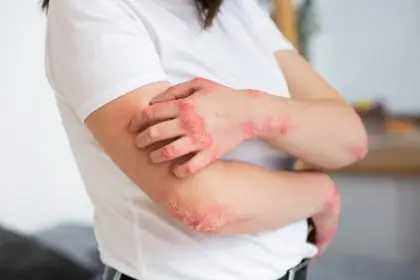In the intricate tapestry of our skin, scars often stand as visible imprints of life’s challenges.
As we explore the realm of green and natural solutions, we embark on a journey to naturally erase scars.
This comprehensive guide is more than a collection of remedies; it’s an exploration of the healing powers found in the embrace of nature.
From understanding the physiology of scars to unveiling detailed and effective remedies, let’s delve into a world where scars become a canvas for natural rejuvenation.
How do scars form?
To appreciate the art of naturally erasing each scar, we must first comprehend the canvas they arise from.
Scars are the result of the body’s intricate healing dance.
When the dermis, the skin’s deep layer, is damaged, the body responds by producing collagen fibers to repair the wound.
The unique nature of this repair often leads to the formation of scars, altering the skin’s texture and appearance.
The journey toward naturally erasing scars involves unraveling this complex process and seeking remedies that align with the body’s natural healing mechanisms.
Common Types of Scarring
Scarring is a nuanced and intricate process, and understanding the common types of scarring is crucial for effective scarring management.
Each type carries its unique characteristics, contributing to the diverse landscape of scars individuals may encounter.
Let’s delve into the intricacies of these common types of scarring:
Hypertrophic Scar:
- Appearance: Raised and often red in color.
- Characteristics: Hypertrophic scars result from an overproduction of collagen during the healing process. They tend to stay within the boundaries of the original wound and can be sensitive or itchy.
- Causes: Commonly associated with traumatic injuries, surgical wounds, or severe acne.
Atrophic Scar:
- Appearance: Indented or depressed areas on the skin.
- Characteristics: Atrophic scars develop when there is a loss of tissue during the healing process. They can take the form of icepick, boxcar, or rolling scars, each with distinct features.
- Causes: Often seen in individuals with a history of severe acne or conditions that cause a loss of collagen.
Keloid Scar:
- Appearance: Thick, raised, and extends beyond the original wound.
- Characteristics: Keloids result from an overproduction of collagen that extends beyond the wound site. They can be larger than the original injury and have a tendency to recur after removal.
- Causes: More prevalent in individuals with darker skin tones and can be triggered by minor injuries or surgeries.
Contracture Scars:
- Appearance: Tightened or constricted skin.
- Characteristics: Contracture scars occur when large areas of skin are lost or damaged, leading to the tightening of the surrounding tissue. These scars can limit movement and may affect deeper layers of tissue.
- Causes: Typically associated with burns, where extensive damage results in the skin tightening as it heals.
- Appearance: Varied, including icepick, boxcar, and rolling scars.
- Characteristics: Acne scars can manifest in different forms based on the severity of the acne and the healing process. Icepick scars are narrow and deep, boxcar scars are broader with defined edges, and rolling scars create a wave-like appearance.
- Causes: Result from severe or prolonged acne, where inflammation and tissue damage play a role.
Stretch Marks (Striae):
- Appearance: Linear streaks or bands on the skin.
- Characteristics: Stretch marks occur when the skin is stretched beyond its usual limits, leading to the tearing of the dermis. They often start as red or purple and fade to a silvery color over time.
- Causes: Common during rapid growth phases, pregnancy, or significant weight gain.
Boxcar Scars:
- Appearance: Broad, depressed areas with well-defined edges.
- Characteristics: Boxcar scars have a box-like appearance with defined edges. They result from the loss of tissue and collagen during the healing process.
- Causes: Often associated with inflammatory conditions, such as acne.
Icepick Scars:
- Appearance: Deep, narrow pits on the skin.
- Characteristics: Icepick scars are small, deep holes in the skin, resembling the marks left by an ice pick. They result from the loss of tissue during the healing process.
- Causes: Commonly associated with severe acne and inflammation.
Understanding these common types of scarring provides a foundation for selecting appropriate natural remedies.
Tailoring the approach based on the specific characteristics of the scar ensures a more targeted and effective journey towards natural scar reduction.
How to Remove Scars at Home
The desire to naturally remove scars leads us to the heart of our homes, where simple yet powerful remedies await.
These DIY solutions provide a chemical-free and accessible approach to scar reduction, allowing individuals to take an active role in their skincare routine.
Let’s explore a range of effective methods for removing each scar at home:
10 Remedies to Erase Scars Naturally
1.Aloe Vera:
How to Use: Extract fresh aloe vera gel from the leaves.
Apply the gel directly to the scar and massage gently.
Why it Works: Aloe vera is renowned for its anti-inflammatory and regenerative properties.
It soothes the skin, reduces inflammation, and promotes healing.
2. Coconut Oil:
How to Use: Gently massage virgin coconut oil onto the scarred area.
Why it Works: Rich in fatty acids, coconut oil nourishes the skin, encourages collagen production, and helps improve the texture of scars over time.
3. Lemon Juice:
How to Use: Dilute fresh lemon juice with water and apply it to the scar using a cotton ball.
Why it Works: The natural acidity of lemon juice exfoliates the skin, promoting cell turnover and lightening the appearance of scars.
4. Honey:
How to Use: Apply raw honey directly to the scar and let it sit for 15-20 minutes before rinsing.
Why it Works: Honey’s humectant properties retain moisture, aiding in the healing process and reducing the visibility of scars.
5. Rosehip Seed Oil:
How to Use: Gently massage a few drops of rosehip seed oil onto the scarred area.
Why it Works: Packed with vitamins and antioxidants, rosehip seed oil promotes skin regeneration and helps improve the overall texture of scars.
6. Lavender Oil:
How to Use: Mix a few drops of lavender oil with a carrier oil (like coconut or jojoba) and apply to the scar.
Why it Works: In addition to its delightful scent, lavender oil possesses skin-healing properties that can contribute to scar reduction.
7. Onion Extract:
How to Use: Apply a cream containing onion extract or directly rub fresh onion juice onto the scar.
Why it Works: Onion extract has been studied for its potential in scar reduction, with some evidence supporting its efficacy.
8. Turmeric:
How to Use: Create a paste using turmeric powder and water, then apply it to the scar.
Why it Works: Turmeric’s anti-inflammatory properties can help reduce swelling and redness associated with scars.
9. Apple Cider Vinegar:
How to Use: Dilute apple cider vinegar with water and use it as a toner on the scar.
Why it Works: The acidity of apple cider vinegar promotes exfoliation, helping to renew the skin and reduce the appearance of scars.
10. Calendula:
How to Use: Infuse calendula flowers in oil and apply the oil to the scarred area.
Why it Works: Calendula’s anti-inflammatory and antimicrobial properties make it a gentle yet effective remedy for scar reduction.
When incorporating these remedies into your skincare routine, consistency is key.
Each method offers a unique approach to scar reduction, and combining several remedies may enhance their collective effectiveness.
Remember, natural remedies take time to show results, so patience and regular application are essential for achieving the desired outcome.
Conclusion
In concluding this journey, it’s essential to recognize that each scar tells a unique story.
Embracing the natural remedies presented here is not just about erasing scars; it’s about embracing the journey towards naturally rejuvenated skin.
Patience and consistency become the companions on this path, allowing nature’s healing powers to work their magic over time.
As we conclude this exploration, let the canvas of your skin tell a story of resilience and natural beauty.
Embrace the journey, and let the power of green and natural remedies guide you to a place of self-acceptance and healing.
With nature as our guide, the path to naturally erasing scars becomes a celebration of the body’s innate ability to heal and renew.
Embrace the journey, and let your skin tell a story of resilience and natural beauty.
FAQs
Can natural remedies completely erase each scar?
While natural remedies can significantly reduce the visibility of scars, complete elimination may vary.
The effectiveness depends on factors such as the type of scarring, its age, and individual skin characteristics.
Consistent and prolonged use of natural remedies can yield substantial improvements.
How long does it take for natural remedies to show results?
Patience is key when using natural remedies.
Results can vary based on factors like the severity of the scar and the chosen remedy.
Some may experience visible improvements in a few weeks, while others may take several months.
Consistent and dedicated application enhances the likelihood of positive outcomes.
Are natural remedies safe for all skin types?
In general, natural remedies are considered safe for various skin types.
However, individual skin sensitivities vary.
It’s crucial to perform a patch test before widespread use to ensure there are no adverse reactions.
If you have specific skin concerns or conditions, consult with a dermatologist before trying new remedies.
Can natural remedies be used on fresh wounds or recently healed scars?
It’s advisable to wait until a wound is fully healed before applying natural remedies.
For fresh wounds, focus on proper wound care and avoid introducing new substances until the skin has undergone initial healing.
Once the wound has closed, you can gradually introduce natural remedies to support scarring reduction.
Can these remedies be combined for better results?
Yes, combining different natural remedies can potentially enhance their effectiveness.
However, it’s essential to be mindful of individual skin sensitivities and reactions.
Start with one remedy, monitor its effects, and gradually introduce others if desired.
Consulting with a skincare professional can provide personalized guidance.
Do natural remedies work on all types of scars, including surgical scars?
Natural remedies can be effective for various types of scarring, including surgical scars.
However, the approach may need to be tailored based on the specific characteristics of the scar.
For surgical scars, consult with your healthcare provider before using natural remedies, especially if you’re in the post-operative healing phase.





